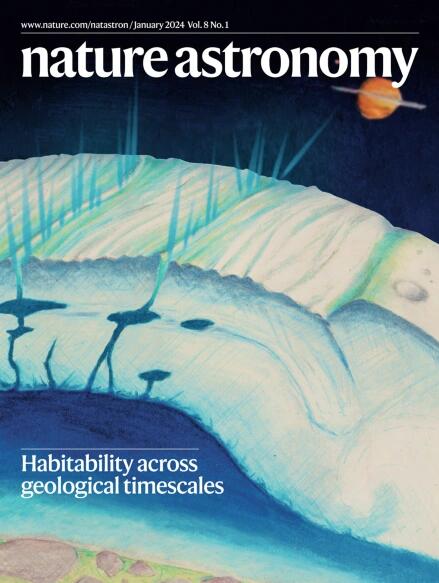Evidence of haze control of Pluto’s atmospheric heat balance from JWST/MIRI thermal light curves
IF 14.3
1区 物理与天体物理
Q1 ASTRONOMY & ASTROPHYSICS
引用次数: 0
Abstract
Pluto and its largest moon Charon display a variety of surfaces, whose thermal and energetic properties are largely unknown. Previous thermal measurements of the Pluto–Charon system yield multiple solutions because most of them did not resolve Pluto from Charon. In addition, recent modelling studies suggest that the atmospheric haze of Pluto could substantially contribute to its mid-infrared emission, thus adding further degeneracy. Here we measure separate Pluto and Charon thermal light curves over 15–25.5 μm with JWST and retrieve the thermophysical and emissivity properties of the different terrains on each. We also detect and measure the thermal emission of Pluto’s haze. The observed fluxes indicate that Pluto’s haze is composed of Titan-like organic particles as well as hydrocarbon and nitrile ices and demonstrate that the haze largely controls Pluto’s atmospheric balance. As a result, Pluto’s temperatures, climate and general circulation should therefore be substantially affected by the haze across seasons. The MIRI spectrometer onboard JWST measured Pluto and Charon’s infrared emissions separately, uncovering surface properties and revealing that Pluto’s haze plays a key role in controlling the atmospheric temperature.


来自JWST/MIRI热光曲线的雾霾控制冥王星大气热平衡的证据
冥王星和它最大的卫星冥卫一显示出各种各样的表面,其热和能量特性在很大程度上是未知的。之前对冥王星-卡戎系统的热测量得出了多种答案,因为大多数都没有将冥王星和卡戎区分开来。此外,最近的模拟研究表明,冥王星的大气雾霾可能在很大程度上促进了它的中红外发射,从而增加了进一步的简并。利用JWST分别测量了冥王星和卡戎在15-25.5 μm范围内的热光曲线,获取了不同地形的热物理和发射率特性。我们还探测和测量了冥王星雾霾的热辐射。观测到的通量表明,冥王星的雾霾是由类似泰坦的有机颗粒以及碳氢化合物和腈冰组成的,并表明雾霾在很大程度上控制了冥王星的大气平衡。因此,冥王星的温度、气候和大气环流应该会受到跨季节雾霾的严重影响。
本文章由计算机程序翻译,如有差异,请以英文原文为准。
求助全文
约1分钟内获得全文
求助全文
来源期刊

Nature Astronomy
Physics and Astronomy-Astronomy and Astrophysics
CiteScore
19.50
自引率
2.80%
发文量
252
期刊介绍:
Nature Astronomy, the oldest science, has played a significant role in the history of Nature. Throughout the years, pioneering discoveries such as the first quasar, exoplanet, and understanding of spiral nebulae have been reported in the journal. With the introduction of Nature Astronomy, the field now receives expanded coverage, welcoming research in astronomy, astrophysics, and planetary science. The primary objective is to encourage closer collaboration among researchers in these related areas.
Similar to other journals under the Nature brand, Nature Astronomy boasts a devoted team of professional editors, ensuring fairness and rigorous peer-review processes. The journal maintains high standards in copy-editing and production, ensuring timely publication and editorial independence.
In addition to original research, Nature Astronomy publishes a wide range of content, including Comments, Reviews, News and Views, Features, and Correspondence. This diverse collection covers various disciplines within astronomy and includes contributions from a diverse range of voices.
 求助内容:
求助内容: 应助结果提醒方式:
应助结果提醒方式:


